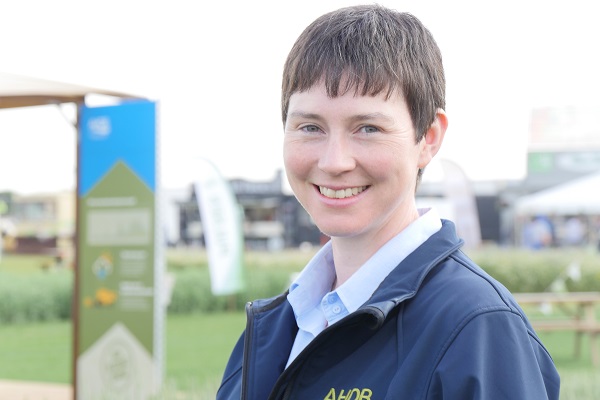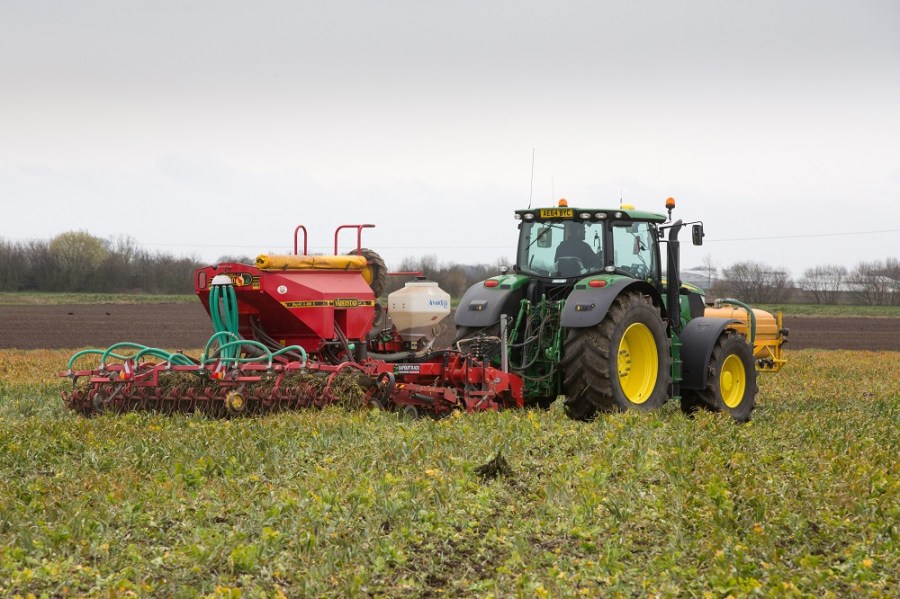With cover cropping in vogue across all sectors, there’s still much to learn. CPM discovers how the missing pieces of the knowledge jigsaw are being put into place.
We’re on that ‘slope of enlightenment’ now.
By Lucy de la Pasture
In recent years cover crops have become all the rage. With many growers putting their toes in the water with little cover crop experience to draw on, it’s often difficult to choose the right seed mix with confidence and achieve the desired result.
NIAB TAG’s head of farming systems research, Ron Stobart has been involved with cover-crop research for many years and explains they are moving through the five stages of the ‘hype cycle’; a ‘technology trigger’ where cover crops were the next big thing, followed by a peak of ‘inflated expectation’ where cover crops were the answer to any number of problems.
“Then the point comes when people have tried out a few different things and haven’t got the results they were expecting, which leads to the ‘trough of disillusionment’. Then comes the stage when everyone calms down and actually works out how to make the technology work for them and we’re on that ‘slope of enlightenment’ now.

The Maxi-Cover project will look at the two crops following the cover crop to establish its benefit over the rotation.
“The final part of the cycle is ‘the plateau of productivity’ where knowledge
gaps have been filled and the technology becomes an integrated part of production,” he adds.
Recognising that the many strands of information on cover crops needed bringing together, AHDB Cereals and Oilseeds recently funded a research review, conducted by ADAS and NIAB. This investigated the science behind growing cover crops and as a result, some glaring gaps in knowledge were identified, explains AHDB’s resource management scientist, Dr Amanda Bennett.
“The review highlights that there’s a need for more robust information in some areas, particularly the characterisation of root systems (rooting depth and architecture) of different cover crop species and their potential under UK growing conditions. Identifying suitable species for different soil types is another area where science has been lacking,” she comments.
“There’s also a big hole in knowledge regarding the benefits cover crops may bring over a period of time so some work needs to be done to assess their cost benefits across the rotation.”
To plug these gaps a new project was commissioned by AHDB last autumn, ‘Maximising the benefits from cover crops through species selection and crop management’ or the Maxi-Cover crop project for short.
ADAS crop physiology research scientist, Dr Charlotte White is leading the project, which is being undertaken by a consortium from ADAS, NIAB, Amazone , Cousins, RAGT and Hutchinsons. She explains what’s hoped to be gleaned from the trials over the next three years.

Charlotte White says the potential benefits of cover crops may not be realised because of gaps in science behind species choice and cultivations.
“The research review highlighted that the potential benefits of cover crops are not always realised on farm because of lack of evidence about which cover crop species is best, how to manage the crop in different situations, limited knowledge of cover crop options, and (in many cases) reliable cultivation technologies do not exist,” she summarises.
“Maxi-Cover is made up of three large-scale plot trials and these field experiments will quantify the effect of ten cover crop treatments (seven straight species and three species mixtures), established using a standard cultivation approach, on soil properties, crop rooting and yield.”
When it came to deciding which species to study, there was plenty of debate over the plethora of options available from seed suppliers, she recalls.
“The final line-up of ‘straight’ species was chosen to reflect the different ‘types’ available and consists of oil radish, spring oats, rye, vetch, crimson clover, buckwheat and phacelia. The mixes are oats and crimson clover; oil radish, phacelia and buckwheat and a third mixture of those five species.”
Amanda Bennett takes up the story and explains the idea is to look at the common options and find out what each species ‘type’ is bringing to the party. We’re often hearing from farmers that they prefer less complicated mixtures because of cost and simplicity so we need more detailed information as to the possible benefits single species may have.”
Oil seed radish is deep rooting and can help with compaction relief as well as N-leaching reduction due to its fast autumn growth. Spring oats are a simple and popular option already widely used, whereas there’s less known about rye, particularly whether there will be any issues with the following spring barley crop, she explains.
“Vetch is a benchmark species for legumes and will be help establish how much N is available to following crops. Crimson clover is a small-seeded legume which is popular in mixes and by planting as a straight, it will allow us to compare the effects of small and large-seeded legumes.
“Buckwheat is less widely used and is frost-sensitive but is a very good phosphate scavenger and there’s also reports that slugs don’t like to eat it. We hope to establish whether the buckwheat has enough time to fulfil its role as a scavenger before frost intervenes. Phacelia is an N-scavenger and is also frost-sensitive but is generally hardier than buckwheat,” she comments.
In-depth assessments on the single species will study rooting, biomass formation and N-uptake to develop more definitive profiles for species ‘types’ so that it becomes easier for growers to develop bespoke mixes for their own fields.
The three sites are located on commercial farms and have been chosen for their different soil types and geographical location, being situated at Yorks, Cambs and Notts.
The first of the large plot trials, 26m x 6m, was drilled last autumn at the Cambs site. The impact of the cover crop approaches will be assessed through soil health measurements, including soil moisture, soil organic matter, earthworm counts, soil strength and soil nutrient content (P, K and Mg), explains Charlotte White.
“One of the important aspects of the project is that we’ll continue to monitor the effects of the cover crop in the two following cash crops – spring barley and winter wheat or winter oilseed rape, depending on the site,” she adds.
In addition to the large plot trials, the project also has a series of validation tramline trials, which will look at either the cover crop mixes or the influence of cultivation and destruction approach on cover crop success.
These are hosted by three Monitor farms situated at Yorks, Cambs and Kent, and a Hutchinsons’ farm site. There will be eight in total; four replicated tramline trials will evaluate the Amazone Cayena tine drill and the Cousins Micro-Wing against the farm standard establishment techniques. These tramline trials will be carried out on the three-way species mix.
“The other four validation tramline trials will evaluate the cover crop mixes, comparing two of the mixes against a control. Each of the validation trials will consist of 2-3 replications, depending on field size.
“Assessments will be less in-depth than for the large plot trials but will look at early spring crop rooting (cover crop validation trials), soil assessments and be taken to yield in the two following crops,” explains Charlotte White.
The project also includes a detailed cost-benefit analysis of all associated seed, establishment, destruction and management costs and the productivity of the following cash crops for the validation trials.
It’s still early days for Maxi-Cover but interim findings will be promoted during the lifespan of the project, including at the AHDB Monitor Farms where the subject of cover crops regularly comes up and stimulates discussion, says Amanda Bennett.
The real value in the project for levy-payers will become available when it concludes in 2019, with AHDB publication of evidence-based guidance notes on cover cropping, underpinned by scientific findings uncovered in both the research review and the agronomic considerations that will come out of the Maxi-Cover project, she emphasises.
“Although the Maxi-Cover project will produce results specific to the sites and species studied, they’ll provide robust, replicated independent scientific data, which help develop best practice guidance and tips over and above the main research review agronomic finding regarding the importance of early establishment in a successful cover crop.
Interest in cover cropping doesn’t stop at the Maxi-Cover project, with nine Monitor farmers involved in ‘try-outs’, growing two cover crop mixes before drilling spring cereals. AHDB’s also funding further research across different sectors, including potato and livestock production.
AHDB Beef and Lamb is investigating the potential of grazing mixes and varieties of cover crops, which includes stubble turnips, mustard, sainfoin, Lucerne and red clover, through their Farm Innovation Grant Scheme (FIGS) and other projects.
“The aim is to provide a case study for existing beef and sheep producers who are considering using alternative grazing crops, as well as acting as a blueprint for arable farms considering bringing livestock back onto their farms to improve soil conditions and tackle weed issues,” explains Amanda Bennett.
“One of the best ways of furthering knowledge about cover cropping is by farmers, who have already done the hard work in finding cover crops that suit their farming system, sharing their experiences with others,” she comments.
With this in mind, AHDB has published seven short studies, which were carried out in conjunction with ADAS as part of the review, and features farmers talking about their experiences using cover crops. These can be found of the AHDB dedicated cover crops web page cereals.ahdb.org.uk/covered.
Learning from experience
David Blacker is one of the three AHDB Monitor farmers hosting the Maxi-Cover project on his farm in the Vale of York. With four years of experience under his belt experimenting with cover crops, he feels there’s still plenty to learn on the subject.
“Most of the information available on cover crops is from work done in Europe and the United States. It’s been a steep learning curve for me and we need to understand better how to grow cover crops under UK conditions,” he comments.
He cites the main reason for adopting cover crops on his farm as a way of helping his soil structure over the winter. The 890ha under his care is predominantly clay loam and silty clay loam over clay – soil types which are prone to capping and slumping over the winter, he explains.
“It’s fair to say that our soil was reasonably well abused so getting some structure back into the soil and improving porosity is one of our main objectives. To achieve this, we’re using a mixture of species with different rooting profiles and types.”
Finding the right species mixture to suit both the soil type and rotation has been a process of trial and error but David Blacker now has now refined his cover crop to a five-way mix that’s delivering the desired results.
“We set out with radish in the mix for its deep rooting properties but it didn’t suit us with oilseed rape in the rotation. Vetch was another species that we tried but found expensive and didn’t really work for us because we also grow beans on the farm,” he says.
The basis of his cover crop is spring oats, which is farm-saved and low-cost but provides a cereal break. Phacelia, buckwheat, sunflower and berseem clover are the other ingredients that together provide the different rooting properties David Blacker is looking for.
One of the factors he highlights when it comes to getting the cover crop to establish, is that seed size needs to be taken into account when drilling the crop. On his farm cover crops are destroyed with glyphosate and he drills into the trash using a Mzuri strip-tillage drill.
“The trouble with some off-the-shelf mixes is that if they’re drilled at a depth to suit the larger seeds, then smaller seeds like clover will never emerge. I split the seed into small and large seeds, drilling the large seeds through the coulters but broadcasting the small seed behind, then harrowing and rolling them in,” he says.
This season he has Maxi-Cover tramline trials on the farm which are looking at two different seed mixes chosen for the project.
“I’m really interested to see the results of the rooting depth assessments, and put some science behind the subject. Another area which will be enlightening is the assessments due to be made in the following crops.
“We don’t really know when the nutrients captured by the cover crop are released and when the benefits of this will be recouped,” he says.
Research round-up
AHDB Project No. 21140009
Maximising the benefits from cover crops through species selection and crop management (Maxi-Cover crop) is a three-year project led by ADAS, which began in Aug 2016 and is costing £230,000 (total funding £315,300). It follows on from the AHBD Project No. 2140033125, ‘A review of the benefits, optimal crop management practices and knowledge gaps associated with different cover crop species’, which completed in July 2016 and cost £26,347.
The Maxi-Cover project aims to maximise the potential economic, agronomic and ecological benefits from cover crops through a better understanding of species effects and crop management technologies, with four objectives: i) quantify the effects of different cover crops on soil properties, crop rooting and yield, and develop bespoke cover crop seed mixtures; ii) validate the effects of different cover crop mixtures and new cultivation/destruction technologies on AHDB Monitor Farms; iii) update cover crops guidance; iv) transfer knowledge of the project findings to growers, industry and academia.




